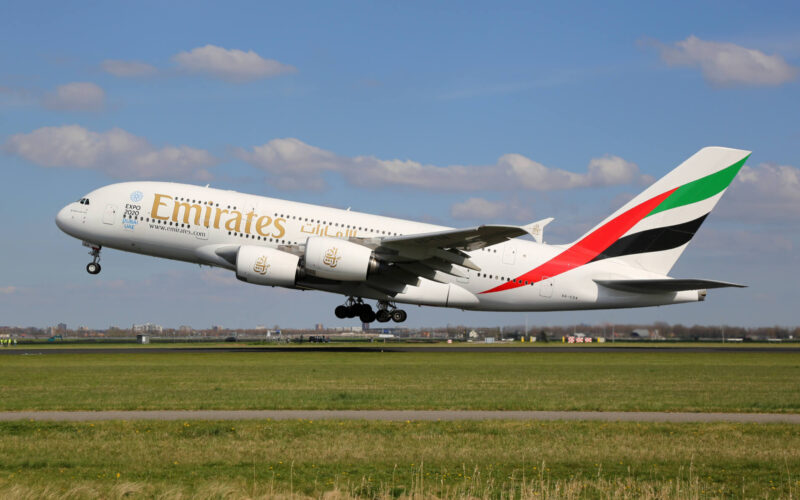While Emirates has become synonymous with the Airbus A380 and is, despite the current unfavorable circumstances, optimistic about the aircraft’s future, the relationship was not as rosy as it might appear at first sight. While the story has developed into a beautiful marriage, whereupon the A380 has become a beautiful, white swan to Emirates, others have rejected it to be an ugly duckling as the current crisis raged on.
“A very serious issue“
In events that shocked nobody, the Airbus A380 program ran into delays. And delays meant trouble for operators that planned to have the aircraft by a certain time, as expansion plans were drawn up beforehand.
The Dubai airline was no exception. When the European manufacturer announced more delays to the deliveries of the aircraft in October 2006, Emirates’ own President Tim Clark had enough.
“This is a very serious issue for Emirates and the company is now reviewing all its options,” Clark stated at the time. The executive argued that the delivery delays would slow down the airline’s ambitious plans. Upon the initial order of the double-decker, it expected to receive them in September 2006, a month prior to Clark’s comments.
“If there is a further delay, as our first delivery is now set for August 2008, there may be cancellations down the line,” Clark reiterated his point in mid-October 2006. “I hope Airbus puts their house in order,” he affirmed, as Emirates had “invested a lot in ground facilities so we have to stick with the order for now.” Furthermore, the A380 was in a league of its own regarding its capacity and with ambitious growth plans, as at that point, there was nothing that came close to the double-decker, added Clark.
Unfortunate crisis and fat shaming
The aircraft finally reached Dubai upon delivery in July 2008, when A6-EDA arrived in the United Arab Emirates city. Yet it had a problem and it was shamed for it.
“We have not yet engaged with Airbus as regards not only the delay but the fact that it is overweight,” Clark commented on the situation in late-October 2006. While hindsight is always 20/20, that was a huge problem at the time – the 2008 financial crisis was oncoming, and with it, a huge spike in oil prices. Steadily rising since the early-2000s, they peaked in July 2008 at $147 per barrel. Flying such a behemoth with four engines, coupled with a sharp increase in fuel costs, became a costly affair. Fuel-related expenses spiked for Emirates, as it outlined in its FY2008 financial report that fuel comprised 36.2% of its operating costs, an increase of 18.8% compared to FY2007.
“In the financial year 2008/09, the group met these awesome challenges with determination, improved efficiency and fresh, market-leading initiatives,” commented on the year’s results chairman and chief executive of Emirates Ahmed bin Saeed Al-Maktoum in May 2009.
Slimming down the A380, amidst the rapid surge in fuel prices, was “immense pressure,” Tom Williams, a now-retired executive of Airbus, stated in July 2008. All in all, the manufacturer wanted to trim as much as three tons off the weight of the Super Jumbo in order to improve the overall package of the A380.
Nevertheless, Emirates always knew that they had found a jewel.
“The Emirates A380 double-decker launched a new era, evoking the leisurely travel of cruise ships, with a Shower Spa in First Class, the first-ever for a commercial airline and a spacious onboard Lounge for premium passengers,” Clark added to Al-Maktoum’s comments of May 2009.
Even with the announced weight issues in October 2006, the British executive remarked that the aircraft “will still be a hugely potent profit generator for us,” and that the A380 would remain an integral part of the airline’s future.
Running its course
While it has so far remained an integral part of the airline’s fleet, much like every relationship between an aircraft and an airline, it slowly has begun to run its course.
The Airbus A380 might have its advantages, but it also has its fair share of downsides. The high operating and acquisition costs, relative inflexibility in terms of where it can be deployed to remain profitable make for a bad combination in a world where one must remain flexible in order to weather the crisis. After all, Emirates paused its Super Jumbo operations for four months between March and July 2020, as simply put there were not enough passengers to employ the A380. In addition, the double-decker can hold up to 88 cubic meters of cargo in its belly, while the Boeing 777-300ER – up to 125 cubic meters. Cargo was a major driver of revenue throughout the crisis.
“The revenue we’re getting from cargo is substantial. Not only it allows us to cover our operating costs, but it also allows us to make profits,” said Tim Clark.
Throughout the 2010s, Emirates pushed hard for Airbus to introduce a stretched or a re-engined variant of the Super Jumbo.
Alas, it never materialized. The A380 had run its course even before the current crisis began. On the saddest Valentine’s Day to #AvGeeks in 2019, the manufacturer and the airline agreed to reshuffle the latter’s order book, reduce the total order for the A380 from 162 to 123 aircraft and instead, take up 40 Airbus A330-900neo and 30 Airbus A350-900 aircraft.
Still, Clark remains optimistic. Despite the current downturn, and the lackluster demand for international travel, Emirates expects to fly its whole fleet of A380s by 2022, the same year their last delivery is now scheduled to take place.
“My own view, and it’s always an optimistic view, is by end of next calendar year or the first quarter of 2022 we’ll have all our A380s flying.”

